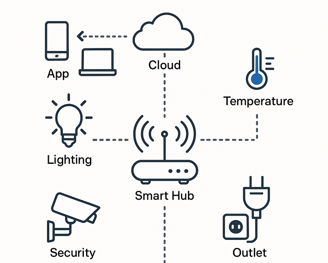
Home Automation
• SOLUTIONS •
Objective is to automate and remotely control household devices such as lighting, HVAC, security, and appliances using smart technology — enhancing convenience, security, and energy efficiency.


Key Components
1. Central Controller (Hub or Gateway)
Acts as the brain of the system.
Connects all smart devices.
Communicates via Wi-Fi, Zigbee, Z-Wave, or Bluetooth
2. User Interface
Smartphone app or web dashboard.
Used to monitor and control devices.
Often includes voice assistant integration (Alexa, Google Assistant, Siri).
3. Sensors
Motion sensors: detect movement.
Door/window sensors: detect open/close events.
Temperature/humidity sensors.
Smoke/gas detectors.
4. Actuators
Smart lights.
Smart plugs and switches.
Thermostats.
Smart locks and garage openers.
Motorized curtains or blinds.
5. Communication Network
Local Wi-Fi network or mesh network.
Cloud server for remote access and automation logic.
6. Cloud Services
Enable remote control, data storage, and automation rules (e.g., "If motion detected, turn on lights").
Workflow
1. Trigger Event: A sensor detects an event (e.g., motion in a room).
2. Signal Transmission: The sensor sends data to the hub.
3. Decision Logic: The hub processes the data or sends it to the cloud for automation logic.
4. Action Execution: An actuator responds — like turning on a light or sending a notification.
5. User Feedback: Status updates appear on the user's mobile app or dashboard.
Optional Features
1. AI Integration: Learns user behavior to automate routines.
2. Voice Control: Via Amazon Alexa, Google Assistant, Apple Siri.
3. Energy Monitoring: Tracks usage and optimizes energy consumption.
4. Security Features: Real-time alerts, surveillance integration, and remote locking.
GC Technologies
Subscribe to Us
Office 905, Al Serkal 2 Building,
Airport Road, Dubai, UAE
